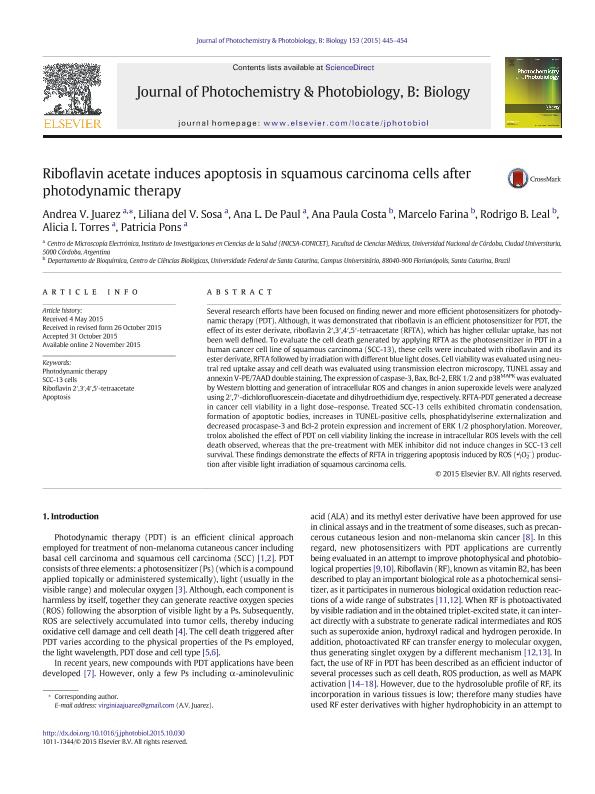Mostrar el registro sencillo del ítem
dc.contributor.author
Juarez, Andrea Virginia

dc.contributor.author
Sosa, Liliana del Valle

dc.contributor.author
de Paul, Ana Lucia

dc.contributor.author
Costa, Ana Paula
dc.contributor.author
Farina, Marcelo
dc.contributor.author
Leal, Rodrigo B.
dc.contributor.author
Torres, Alicia Ines

dc.contributor.author
Pons, Patricia

dc.date.available
2018-06-29T14:23:16Z
dc.date.issued
2015-11
dc.identifier.citation
Juarez, Andrea Virginia; Sosa, Liliana del Valle; de Paul, Ana Lucia; Costa, Ana Paula; Farina, Marcelo; et al.; Riboflavin acetate induces apoptosis in squamous carcinoma cells after photodynamic therapy; Elsevier Science Sa; Journal of Photochemistry and Photobiology B: Biology; 153; 11-2015; 445-454
dc.identifier.issn
1011-1344
dc.identifier.uri
http://hdl.handle.net/11336/50591
dc.description.abstract
Several research efforts have been focused on finding newer and more efficient photosensitizers for photodynamic therapy (PDT). Although, it was demonstrated that riboflavin is an efficient photosensitizer for PDT, the effect of its ester derivate, riboflavin 2′,3′,4′,5′-tetraacetate (RFTA), which has higher cellular uptake, has not been well defined. To evaluate the cell death generated by applying RFTA as the photosensitizer in PDT in a human cancer cell line of squamous carcinoma (SCC-13), these cells were incubated with riboflavin and its ester derivate, RFTA followed by irradiation with different blue light doses. Cell viability was evaluated using neutral red uptake assay and cell death was evaluated using transmission electron microscopy, TUNEL assay and annexin V-PE/7AAD double staining. The expression of caspase-3, Bax, Bcl-2, ERK 1/2 and p38MAPK was evaluated by Western blotting and generation of intracellular ROS and changes in anion superoxide levels were analyzed using 2′,7′-dichlorofluorescein-diacetate and dihydroethidium dye, respectively. RFTA-PDT generated a decrease in cancer cell viability in a light dose–response. Treated SCC-13 cells exhibited chromatin condensation, formation of apoptotic bodies, increases in TUNEL-positive cells, phosphatidylserine externalization and decreased procaspase-3 and Bcl-2 protein expression and increment of ERK 1/2 phosphorylation. Moreover, trolox abolished the effect of PDT on cell viability linking the increase in intracellular ROS levels with the cell death observed, whereas that the pre-treatment with MEK inhibitor did not induce changes in SCC-13 cell survival. These findings demonstrate the effects of RFTA in triggering apoptosis induced by ROS (\O2−) production after visible light irradiation of squamous carcinoma cells.
dc.format
application/pdf
dc.language.iso
eng
dc.publisher
Elsevier Science Sa

dc.rights
info:eu-repo/semantics/openAccess
dc.rights.uri
https://creativecommons.org/licenses/by-nc-nd/2.5/ar/
dc.subject
Photodynamic Therapy
dc.subject
Scc-13 Cells
dc.subject
Riboflavin 2′,3′,4′,5′-Tetraacetate
dc.subject
Apoptosis
dc.subject.classification
Bioquímica y Biología Molecular

dc.subject.classification
Medicina Básica

dc.subject.classification
CIENCIAS MÉDICAS Y DE LA SALUD

dc.title
Riboflavin acetate induces apoptosis in squamous carcinoma cells after photodynamic therapy
dc.type
info:eu-repo/semantics/article
dc.type
info:ar-repo/semantics/artículo
dc.type
info:eu-repo/semantics/publishedVersion
dc.date.updated
2018-06-26T13:45:00Z
dc.journal.volume
153
dc.journal.pagination
445-454
dc.journal.pais
Países Bajos

dc.journal.ciudad
Amsterdam
dc.description.fil
Fil: Juarez, Andrea Virginia. Consejo Nacional de Investigaciones Científicas y Técnicas. Centro Científico Tecnológico Conicet - Córdoba. Instituto de Investigaciones en Ciencias de la Salud. Universidad Nacional de Córdoba. Instituto de Investigaciones en Ciencias de la Salud; Argentina
dc.description.fil
Fil: Sosa, Liliana del Valle. Consejo Nacional de Investigaciones Científicas y Técnicas. Centro Científico Tecnológico Conicet - Córdoba. Instituto de Investigaciones en Ciencias de la Salud. Universidad Nacional de Córdoba. Instituto de Investigaciones en Ciencias de la Salud; Argentina
dc.description.fil
Fil: de Paul, Ana Lucia. Consejo Nacional de Investigaciones Científicas y Técnicas. Centro Científico Tecnológico Conicet - Córdoba. Instituto de Investigaciones en Ciencias de la Salud. Universidad Nacional de Córdoba. Instituto de Investigaciones en Ciencias de la Salud; Argentina
dc.description.fil
Fil: Costa, Ana Paula. Universidade Federal de Santa Catarina; Brasil
dc.description.fil
Fil: Farina, Marcelo. Universidade Federal de Santa Catarina; Brasil
dc.description.fil
Fil: Leal, Rodrigo B.. Universidade Federal de Santa Catarina; Brasil
dc.description.fil
Fil: Torres, Alicia Ines. Consejo Nacional de Investigaciones Científicas y Técnicas. Centro Científico Tecnológico Conicet - Córdoba. Instituto de Investigaciones en Ciencias de la Salud. Universidad Nacional de Córdoba. Instituto de Investigaciones en Ciencias de la Salud; Argentina
dc.description.fil
Fil: Pons, Patricia. Consejo Nacional de Investigaciones Científicas y Técnicas. Centro Científico Tecnológico Conicet - Córdoba. Instituto de Investigaciones en Ciencias de la Salud. Universidad Nacional de Córdoba. Instituto de Investigaciones en Ciencias de la Salud; Argentina
dc.journal.title
Journal of Photochemistry and Photobiology B: Biology

dc.relation.alternativeid
info:eu-repo/semantics/altIdentifier/url/http://www.sciencedirect.com/science/article/pii/S1011134415003590
dc.relation.alternativeid
info:eu-repo/semantics/altIdentifier/doi/http://dx.doi.org/10.1016/j.jphotobiol.2015.10.030
Archivos asociados
